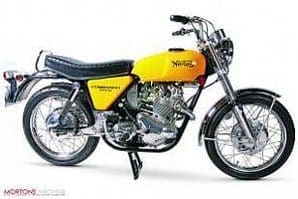
That British factories were run on tight design margins is well known – they never really had the budget for radical new designs. When the dust cleared from the Second World War and peace returned, a different war broke out – the war for sales – and a parallel twin was needed on the front line. If you didn’t have one you would struggle.
Bert Hopwood had envisaged the parallel twin 500 he hurriedly put into production in the late 1940s as a stopgap while his futuristic modular concept was developed. In reality, the die was set for the next 30 years of Norton engines.
 Like other parallel twins, as the capacity and compression ratio grew ever bigger, vibration became a problem – those pictures of young people with poor teeth in the 1960s aren’t because of bad dentistry but parallel twin vibrations… at some point the vibration made the motorcycles almost unrideable. Norton’s answer was to mount the engine on a series of rubber bushes that allowed the engine to vibrate but prevented the vibration from reaching the rider. It worked too, but careless riders, without the warning of vibration, could rev their engines to destruction.
Like other parallel twins, as the capacity and compression ratio grew ever bigger, vibration became a problem – those pictures of young people with poor teeth in the 1960s aren’t because of bad dentistry but parallel twin vibrations… at some point the vibration made the motorcycles almost unrideable. Norton’s answer was to mount the engine on a series of rubber bushes that allowed the engine to vibrate but prevented the vibration from reaching the rider. It worked too, but careless riders, without the warning of vibration, could rev their engines to destruction.
The engine we’re looking at here is the 750cc introduced with the Commando in September 1967. Of similar design to Bert Hopwood’s Model 77 500cc unit it was based around vertically split aluminium crankcases, with a built up crank shaft consisting of a central flywheel with steel forged webs bolted to either side. Alloy con-rods were bolted to the big-end journals and the piston gudgeon pins ran directly in the little end eye. A cast iron barrel with cooling passages between the bores sat on the top of the cases, and an alloy cylinder head topped the lot off. Valves were opened by a single, four lobe camshaft, and the compression ratio was upped to 9:1 with flat topped pistons. This allowed a much shallower combustion chamber and steeper valve angles. Once in the frame the engine would be tipped forward by 15 degrees for a rakish look.
The motor gained a good reputation and long after its road life was over, the sidecar MXers were still winning championships with it. ![]()





